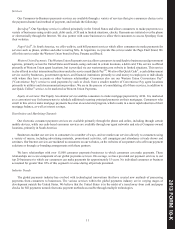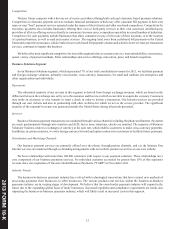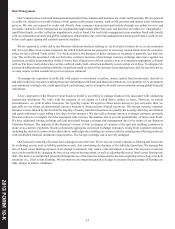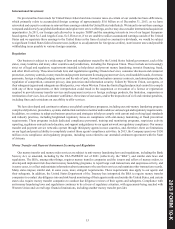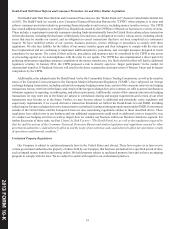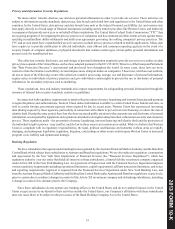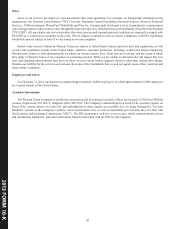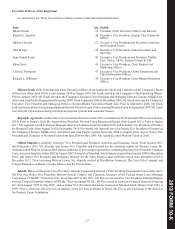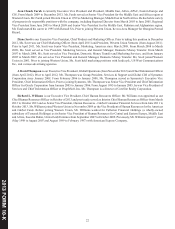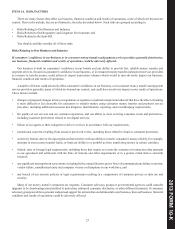Western Union 2013 Annual Report Download - page 124
Download and view the complete annual report
Please find page 124 of the 2013 Western Union annual report below. You can navigate through the pages in the report by either clicking on the pages listed below, or by using the keyword search tool below to find specific information within the annual report.
2013 FORM 10-K
14
Risk Management
Our Company has a credit risk management department that evaluates and monitors our credit and fraud risks. We are exposed
to credit risk related to receivable balances from agents in the money transfer, walk-in bill payment and money order settlement
process. We also are exposed to credit risk directly from consumer transactions particularly through our online services and
electronic channels, where transactions are originated through means other than cash, and therefore are subject to "chargebacks,"
insufficient funds, or other collection impediments, such as fraud. Our credit risk management team monitors fraud risks jointly
with our information security and global compliance departments. Our credit risk management team also performs a credit review
before each agent signing and conducts periodic analyses.
We are exposed to credit risk in our Business Solutions business relating to: (a) derivatives written by us to our customers
and (b) receivables from certain customers for which beneficiaries are paid prior to receiving cleared funds from the customer,
where we have offered "trade credit." For the derivatives, the duration of these contracts at inception is generally less than one
year. The credit risk associated with our derivative contracts increases when foreign currency exchange rates move against our
customers, possibly impacting their ability to honor their obligations to deliver currency to us or to maintain appropriate collateral
with us. For those receivables where we have offered trade credit, collection ordinarily occurs within a few days. To mitigate risk
associated with potential customer defaults, we perform credit reviews of the customer on an ongoing basis, and, for our derivatives,
we may require certain customers to post or increase collateral.
To manage our exposures to credit risk with respect to investment securities, money market fund investments, derivatives
and other credit risk exposures resulting from our relationships with banks and financial institutions, we regularly review investment
concentrations, trading levels, credit spreads and credit ratings, and we attempt to diversify our investments among global financial
institutions.
A key component of the Western Union business model is our ability to manage financial risk associated with conducting
transactions worldwide. We settle with the majority of our agents in United States dollars or euros. However, in certain
circumstances, we settle in other currencies. We typically require the agent to obtain local currency to pay recipients; thus, we
generally are not reliant on international currency markets to obtain and pay illiquid currencies. The foreign currency exposure
that does exist is limited by the fact that the majority of money transfer transactions are paid by the next day after they are initiated
and agent settlements occur within a few days in most instances. We also utilize foreign currency exchange contracts, primarily
forward contracts, to mitigate the risks associated with currency fluctuations and to provide predictability of future cash flows.
We have additional foreign exchange risk and associated foreign exchange risk management due to the nature of our Business
Solutions business. The majority of this business' revenue is from exchanges of currency at the spot rate enabling customers to
make cross-currency payments. Business Solutions aggregates its foreign exchange exposures arising from customer contracts,
including the derivative contracts described above, and hedges the resulting net currency risks by entering into offsetting contracts
with established financial institution counterparties. The foreign exchange risk is actively managed.
Our financial results may fluctuate due to changes in interest rates. We review our overall exposure to floating and fixed rates
by evaluating our net asset or liability position in each, also considering the duration of the individual positions. We manage this
mix of fixed versus floating exposure in an attempt to minimize risk, reduce costs and improve returns. Our exposure to interest
rates can be modified by changing the mix of our interest-bearing assets, as well as adjusting the mix of fixed versus floating rate
debt. The latter is accomplished primarily through the use of interest rate swaps and the decision regarding terms of any new debt
issuances (i.e., fixed versus floating). We use interest rate swaps designated as hedges to increase the percentage of floating rate
debt, subject to market conditions.









